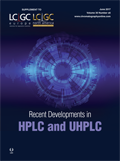Recent Developments in HPLC and UHPLC
Special Issues
An introduction from the guest editor of this special supplement from LCGC Europe and LCGC North America revealing recent developments in high performance liquid chromatography (HPLC) and ultrahigh-pressure liquid chromatography (UHPLC).
Deirdre Cabooter, KU Leuven-University of Leuven, Department of Pharmaceutical and Pharmacological Sciences, Pharmaceutical Analysis, Leuven, Belgium
An introduction from the guest editor of this special supplement from LCGC Europe and LCGC North America revealing recent developments in high performance liquid chromatography (HPLC) and ultrahigh-pressure liquid chromatography (UHPLC).
In the past decade, large efforts have been made to increase the efficiency of liquid chromatography (LC) supports. Conventional 4.6 × 250 mm columns, packed with 5-µm fully porous particles (FPPs) have steadily been replaced by short (5–10 cm), narrow bore (1.0–2.1 mm) columns packed with sub-2-µm fully and even sub-2-µm superficially porous particles (SPPs). The increased column back pressure that is inevitably encountered in columns packed with small particles has largely been overcome by the introduction of instrumentation that can operate at pressures well above 400 bar (currently up to 1500 bar). These new separation supports, in combination with high operating pressures, have made it possible to obtain the same separation quality in much shorter analysis times, or increase the separation quality in the same analysis time, compared to conventional columns.
Another new column format that has been introduced to increase the separation performance is the microâpillar array column. These columns are produced by etching an array of perfectly ordered pillars in a silicon substrate. The perfect order of these pillars significantly reduces the band broadening as a result of heterogeneous flow paths in the column, and hence the overall peak dispersion, while the inter-pillar distance can be tuned to decrease the column back pressure, allowing the use of very long columns. Koen Sandra and his team show how the unique properties of these microâpillar array columns can be used to address challenging separation problems, as encountered in lipidomics. They demonstrate that inter- and intra-class separation of lipids can be obtained on these columns, while isomeric lipids can be resolved as well.
To increase the resolution of a separation, not only the kinetic performance of the column should be improved, but also selectivity aspects should be addressed. This can be done by optimizing both stationary phase and mobile phase conditions. Szabolcs Fekete, Róbert Kormany, and Davy Guillarme show how current method development software can be used to optimize mobile phase conditions, such as gradient time and composition, pH, temperature, and ternary composition, both for small molecules and large biomolecules, and for different retention mechanisms, such as reversed-phase LC, ion exchange chromatography (IEX), and hydrophobic interaction chromatography (HIC).
Whereas optimizing mobile phase conditions on a single stationary phase column can already enhance the resolution of a separation significantly, some complex samples will require multiple stationary phases or retention mechanisms when an adequate separation of all compounds is envisaged. One way to obtain this is by using multiâmode columns that combine two (or more) retention mechanisms in a single column. In a review paper by Caroline West and co-workers, a detailed description of particleâbased mixedâmode stationary phases for LC is presented, followed by an overview of applications with mixedâmode chromatography, including the use of mixed-mode systems in twoâdimensional chromatography.
The development of new chiral stationary phases, which have recently adopted sub-2-µm FPP and sub-3-µm SPP formats to achieve much faster separations, will boost the application of chiral stationary phases in 2D-LC as well. A comprehensive overview of recent developments in chiral stationary phases leading to sub-minute and even sub-second enantiomer separations is given by Michael Lämmerhofer and his team. Some examples of chiral stationary phases in 2D-LC are discussed as well.
The different articles in this supplement show how LC is constantly evolving, driven by the needs of the many areas in (life) sciences and technology wherein it plays a key role. I hope you will read these articles with as much enthusiasm as I did.
It has been a great experience for me to prepare this supplement for LCGC, not in the least because it has allowed me to conjoin with a number of fabulous and talented investigators that for sure will keep pushing the boundaries of LC. I would like to thank all authors for their valuable contributions and look forward to the future developments that await us!
Deirdre Cabooter


New Method Explored for the Detection of CECs in Crops Irrigated with Contaminated Water
April 30th 2025This new study presents a validated QuEChERS–LC-MS/MS method for detecting eight persistent, mobile, and toxic substances in escarole, tomatoes, and tomato leaves irrigated with contaminated water.

.png&w=3840&q=75)

.png&w=3840&q=75)



.png&w=3840&q=75)



.png&w=3840&q=75)








